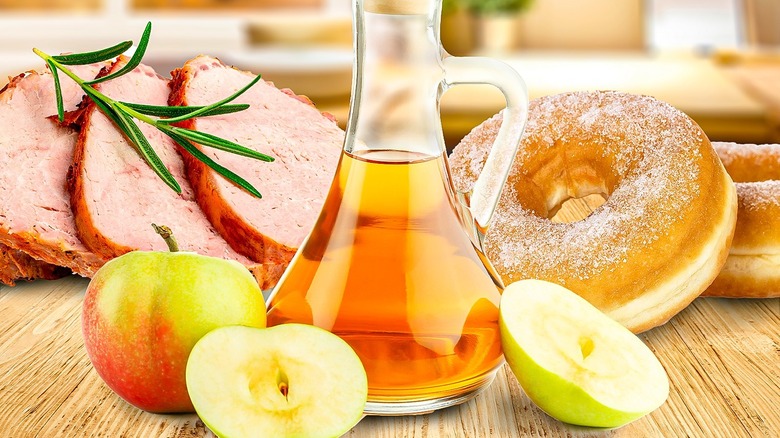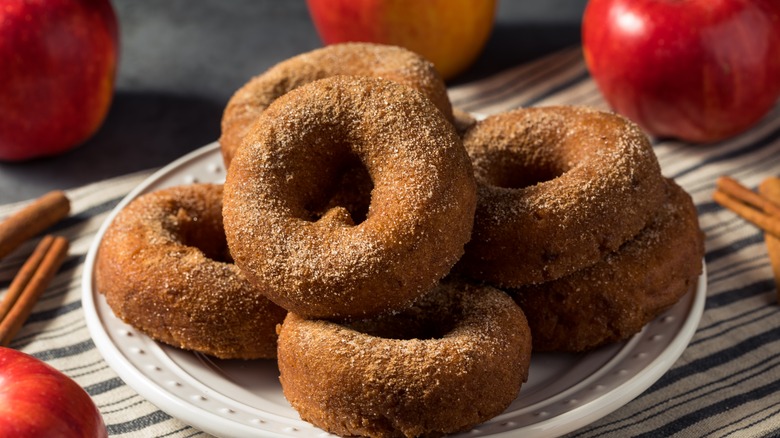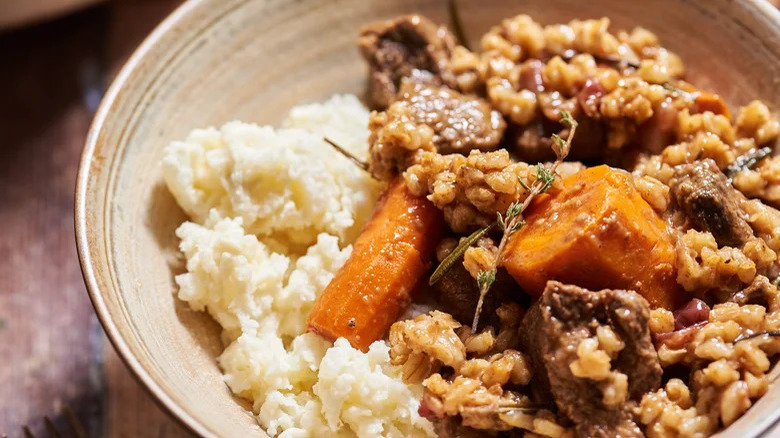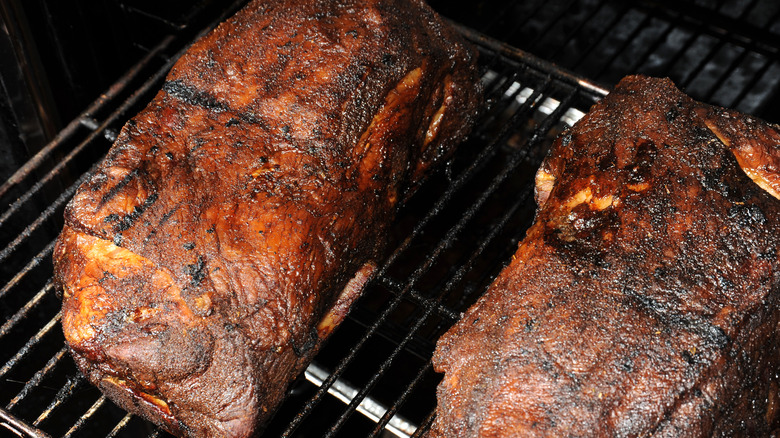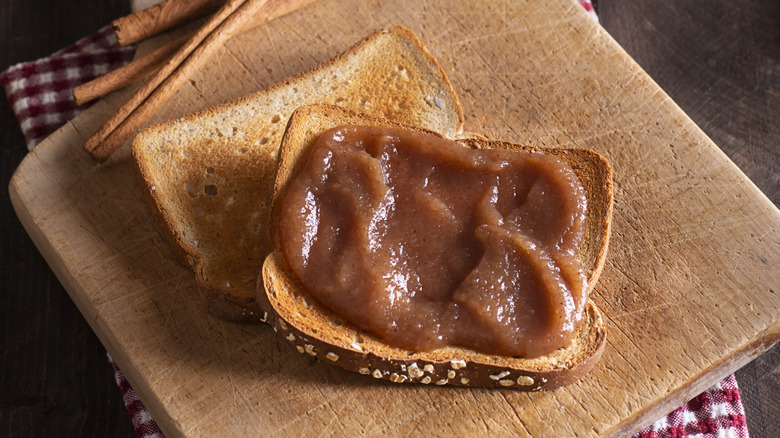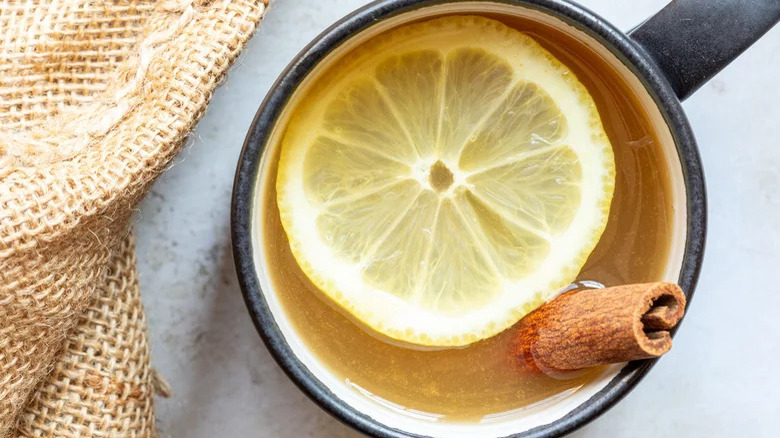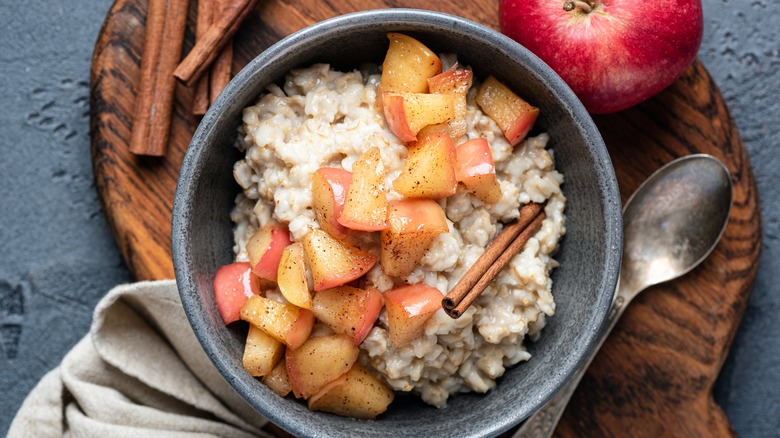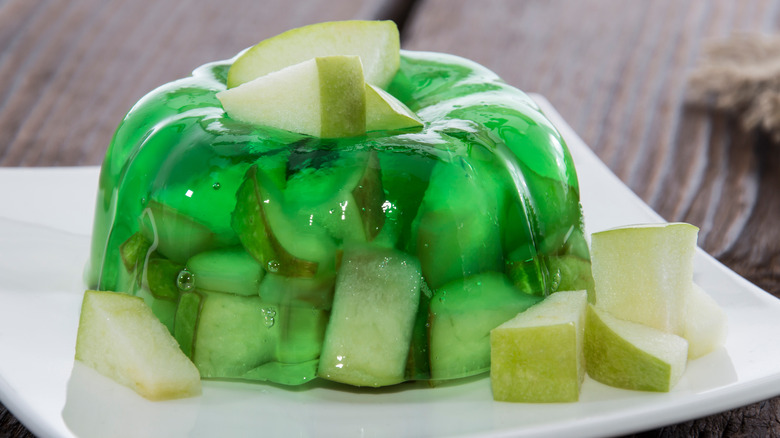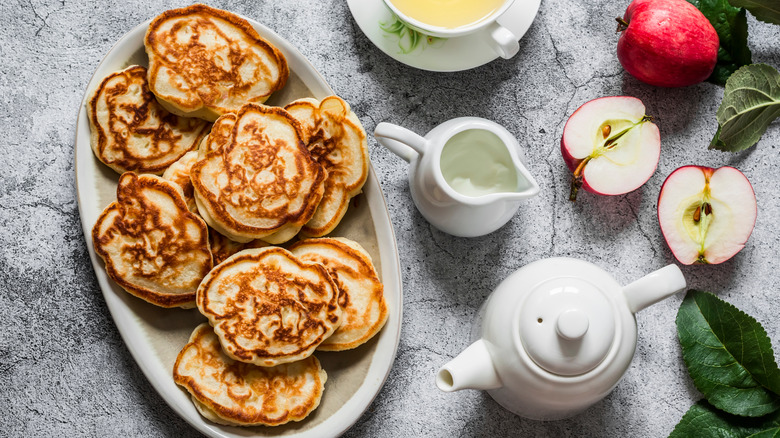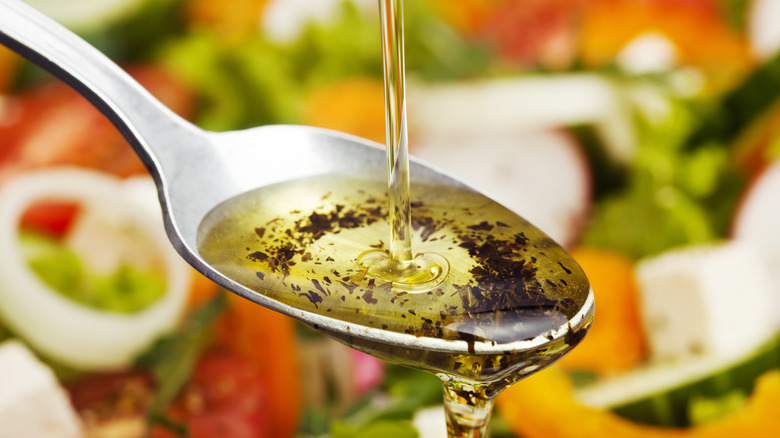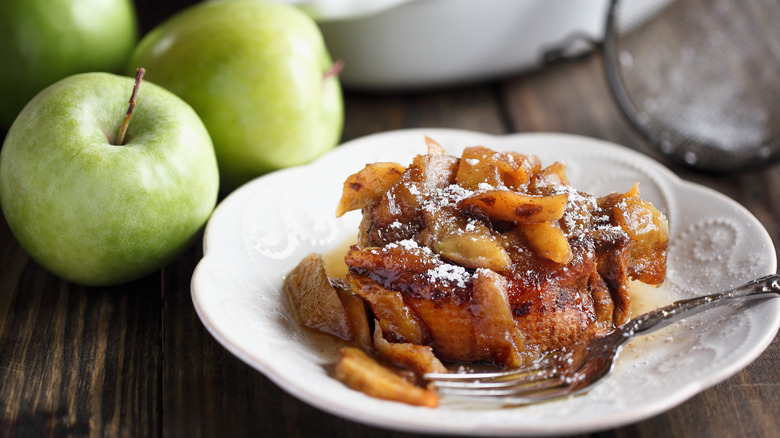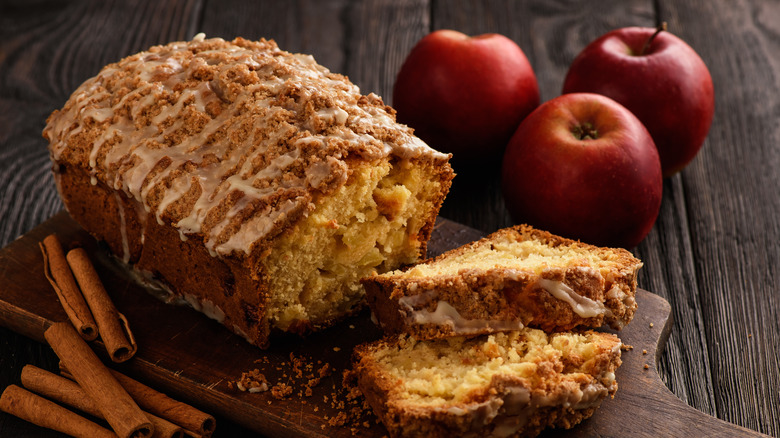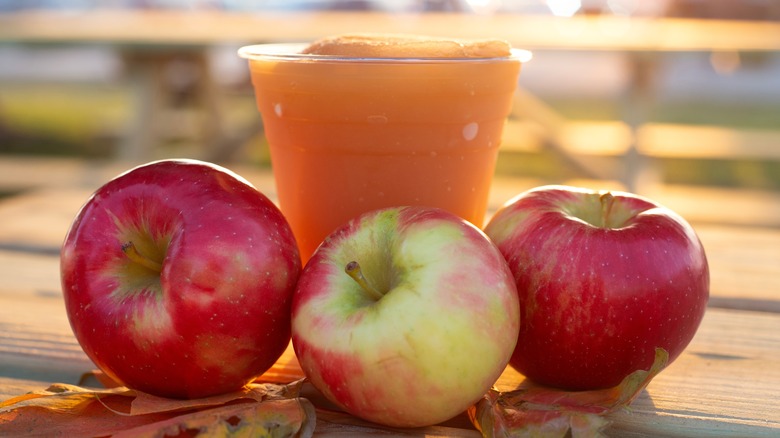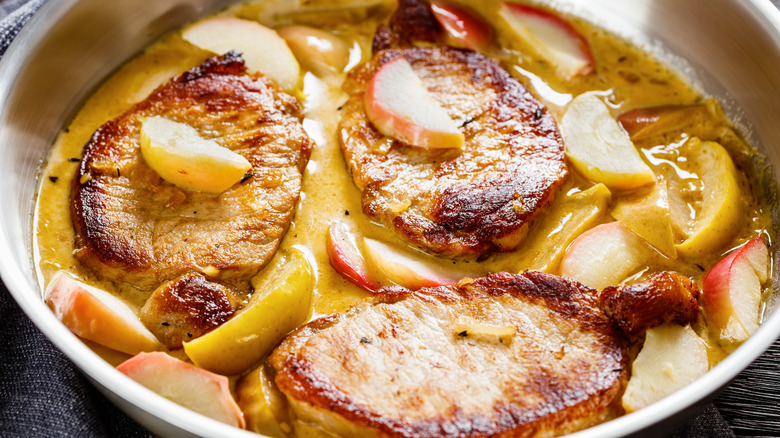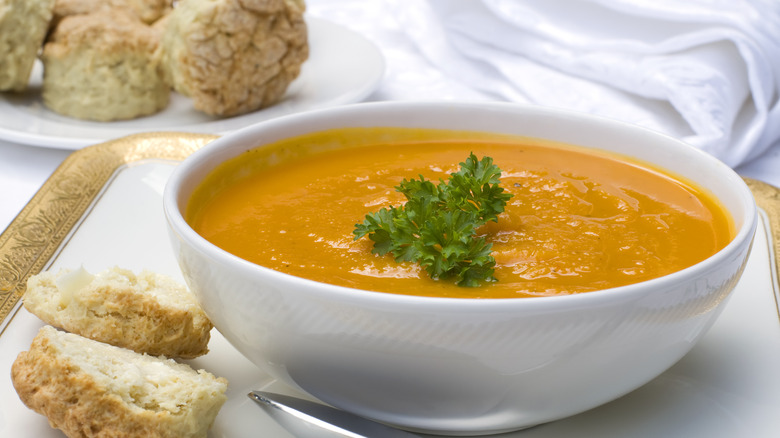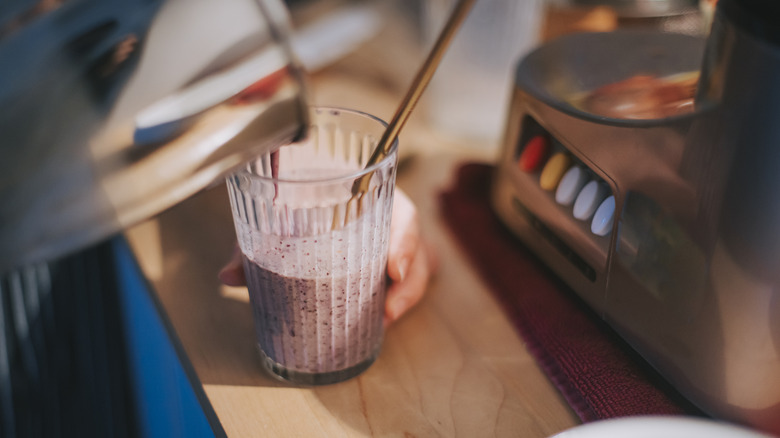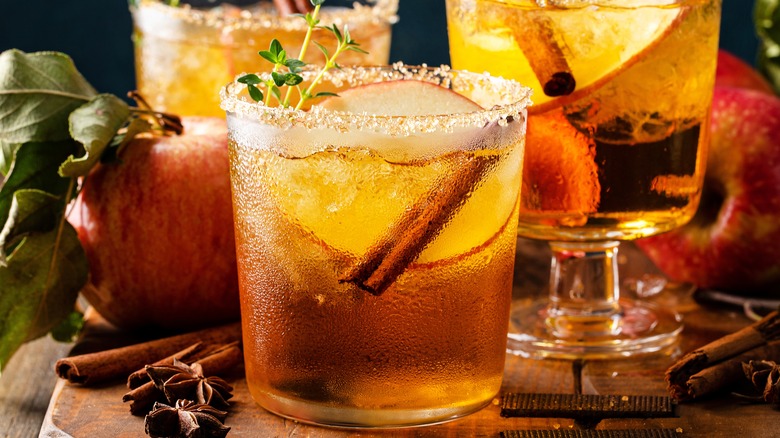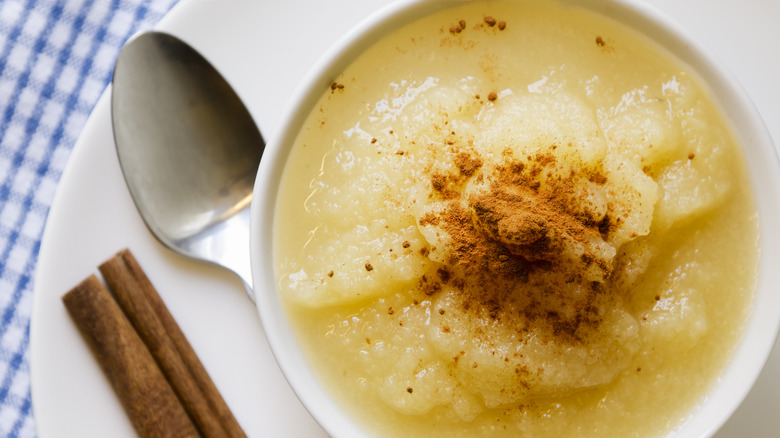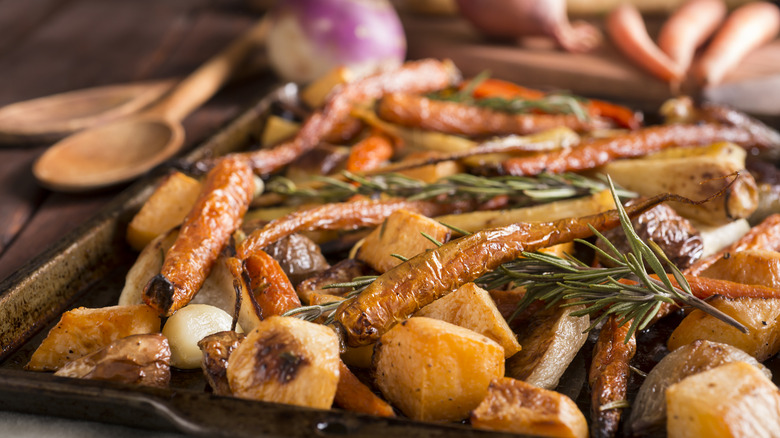20 Mouth-Watering Ways To Cook With Apple Cider
Apple cider is one of the integral ingredients of the fall. Apple cider is different from apple juice because it has an especially short shelf life and undergoes significantly less processing than juice. The minimally processed, unfiltered cider also has a dark, hazy color and a more profound apple flavor sans added sweeteners. Although most people purchase apple cider at their local orchard or grocery store during the fall months, you can also make it at home by mashing the apples and passing them through a fine mesh to strain out the solid pieces.
Since cider has such a short shelf life — at around three days after opening — you might be curious about how to use up the massive jug in your fridge. It's a conundrum we've faced many times, especially after we get home from a trip to the orchard. Here are some of our favorite ways to use up the fall favorite for both sweet and savory recipes that will make you rethink how useful it can be in the kitchen.
Embody fall with apple cider doughnuts
Apple cider doughnuts are one of the classic ways to use up your leftover apple cider. While most folks opt to purchase these warm fall treats, coated in cinnamon sugar, from their local orchard or bakery during the fall months, they are actually a relatively easy recipe to make at home. To maximize the flavor in your doughnuts, you'll want to reduce the cider with cloves, allspice, cinnamon sticks, and orange peel before pouring it into the batter with the flour. This recipe also utilizes other apple ingredients, including apple butter and apple cider vinegar, to get the perfect texture in the batter.
You can also add an extra oomph of cider to your doughnuts by making an apple cider caramel by reducing the apple cider and sugar in a saucepan. The smooth caramel is bright and serves as the perfect sugary accompaniment to the donuts.
Use it in a stew
Apple cider is the delicious ingredient you need to use in your fall and winter stews. Our recipe for cinnamon apple cider beef stew simmers the stew meat, which is often very tough and made specifically for cooking over long periods of time, in a cinnamon apple cider concoction to both soften the meat and infuse it with flavor. You'll also find many familiar fall flavors intertwined into the recipe, including whole cranberries, carrots, rosemary, thyme, and barley.
Stews are the ideal "set-it-and-forget-it" recipe because you can pop it in the slow cooker on low for about eight hours. When it's ready, spoon it over a warm crock of mashed potatoes or pair it with a warm slice of crusty bread or fresh green salad to add some lightness to an otherwise heavy dish.
Flavor your smoked pork
Smoked pork's best friend is apple cider. This ingredient does its job to both soften the meat as it's smoking and infuse it with an apple-y flavor. You'll want to combine the apple cider with apple cider vinegar and apply it to the smoked pulled pork as it's cooking. The key to keeping the moisture on the meat is spraying it often after the first two hours. Once your meat has smoked and adequately rested, you can shred it off the bone with your hands, meat claws, or forks until it resembles thin shreds.
Our favorite way to use this pork is to amplify the apple flavor. Serve it on slider buns with a cider-infused barbecue sauce for a tailgate-friendly treat that everyone will love.
Add flavor to your apple butter
Apple butter is like a thick, caramelized version of applesauce — perfect for spreading on toast, pancakes, or charcuterie board crackers. We use apple cider in our honey apple butter recipe because it amplifies the apple flavor and gives the apples something to simmer in as they soften. Add the apple cider to a pot with roughly chopped, peeled apples, salt, sugar, and honey. The apple cider will help make the mixture more liquidy for easy blending while also acting as a vehicle for your favorite warming spices like cinnamon, cloves, ginger, and allspice.
Once your apple butter has cooled, you can spread it on your breakfast toast or freshly baked treats — or store it in the fridge for later.
Booze things up with a Hot Toddy
The fall and winter months can be tough, but a bright apple cider hot toddy recipe is bound to brighten things up and make you feel warm and fuzzy inside. This cocktail is a mixture of hot apple cider and a Hot Toddy, and it's made with ingredients you likely already have in your kitchen. You can mix your apple cider with light brown sugar, lemon juice, ginger, cinnamon, and bourbon. Modify the recipe to include more brown sugar for sweetness or use more alcohol to make it a bit boozier.
You'll want to start making this cocktail by combining the cider with the spices and sugar to make a thick syrup. Once the mixture has cooked down and thickens, you can strain out the aromatics and add in your booze and lemon juice, serving it warm, or keep the container in a slow cooker to spread some joy at your holiday parties.
Make it into a seasonal cake
Apple cider cake is a delicious way to use up the leftover apple cider in your refrigerator. This cake is essentially a play on an apple cider doughnut, but it's in a form that's a bit easier to slice. The key to this recipe is to seek help from more than just the apple cider. You can add whole apples to your recipe for extra moisture and fiber, and some recipes will even add apple sauce to the batter to help give it extra moisture.
Our recipe gets its soft, moist structure from whipped egg whites and its flavor from a reduced apple cider that is added to both the batter and the crème fraîche whipped cream frosting piped on top.
Infuse it into simple syrup
You don't just have to make cocktails that are all apple cider-based. Instead, making a simple syrup with the juice is a much better way to add flavor to your recipe. Instead of using water in your simple syrup recipe, substitute it with equal parts apple cider. Since apple cider is naturally sweet, you can also tweak the amount of sugar you're adding to the pan or make it your own with different spices like cinnamon and allspice.
Your infused syrup can be used for a range of cocktails, including a fall Old Fashioned or whiskey sour. Don't let the alcohol be the only place where you can use this syrup, though. You can also add it to your lemonade or iced tea or swirl it into ginger ale for a fall twist. This syrup makes it easy to mix sweetness into your recipe and adds more complexity to your beverages.
Swap it for the liquid in your oatmeal
Plain oatmeal can get monotonous quickly. If you're looking to amp up the flavor of your oatmeal, try adding apple cider to it instead of water or milk. It will concentrate the apple flavor into your oatmeal, plus it will compliment other flavorful additions like pumpkin seeds, cinnamon, cloves, and allspice.
You can use the whole old-fashioned oats or quick-cooked oats for this recipe. It will also work if you use a microwave-friendly recipe or cook the mixture on your stovetop. You can also go a step further and cook up some apple slices in cider and maple syrup to create a fruity, autumnal topping for your bowl. When apple cider is around, you'll never look at a plain bowl of oatmeal the same way ever again.
Use it for Jell-O shots
Shots, shots, shots! You'll want to have this boozy dessert at your fall parties, Halloween celebrations, and college kickbacks. Most of the time, Jell-O shots are made with water, powdered gelatin mix, and alcohol. But by swapping out the water with a more flavorful liquid, like apple cider, you'll get a much more flavorful shot. Our caramel apple witch's cauldron Jell-O shots use plain, unflavored gelatin (bloomed with the cider), caramel vodka, and food dye. You can color the dye into whatever shade you'd like or pour the cups into cauldron molds and top them with green boba pearls for the Halloween effect.
Although you can use flavored Jell-O for your recipe, finding a flavor that works well with the cider is hard. Therefore, sticking to the plain gelatin will give you a bit more creative license to make your dessert.
Add fall flavor to your pancakes
Plain pancakes are bland. Instead of making your boxed pancake batter with water and eggs, try adding apple cider to the batter instead. The benefits of this substitution are two-fold. First, the apple cider in the recipe imparts a floral flavor to the batter, while the acid in it activates the leavening agents (baking soda and powder) to help give the pancakes their rise.
To build on the apple flavor in your pancakes, you should also add an apple topping to your recipe. Cook down the fresh apple pieces with brown sugar, melted butter, and cinnamon on the stove.
Mix it into your salad dressing
Salad dressing is usually comprised of straightforward ingredients like acid, vinegar, and herbs. If you want to add a subtle sweetness to your dressing, pour in a splash of apple cider. Warm apple cider dressing is the perfect pairing for fall salads because it balances out the spicy or bitter components of the salad. The ingredient works well with a myriad of salad ingredients, including sharp, butter arugula, warm roasted squash, dried fruits like raisins and cranberries, and fatty nuts like pecans and walnuts.
The key to making an apple cider dressing work is to mix it with apple cider vinegar in a saucepan with aromatics. Then, cook the water off and concentrate the flavors. From there, you can add more ingredients to your salad dressing to make it more robust, like Dijon mustard.
Use it for French toast
French toast opens up a world of opportunities for adding flavor, including autumnal ingredients like apple cider. You can add this ingredient to your French toast bake for a sweet, fall flavor and a wholesome way to start your day. Start by cooking apple pieces down in apple cider to concentrate the flavor and soften the fruit. Pour the mixture over your custard-soaked bread pieces and bake the mix until it's firm and fragrant.
There are tons of opportunities for topping your French toast with other classic pairings, like whipped cream or crème anglaise. You can also do a streusel topping with brown sugar, flour, and butter to add a crumbled texture to the top of your breakfast.
Use it for quick breads
Move over pumpkin bread, there's a new sheriff in town. You can add your leftover apple cider to enhance the flavor of your quick bread. Fresh spiced cider will improve the flavor of your bread — which is also made with chopped apple pieces and sometimes applesauce — and will help wake up the leavening agents to give it a perfect rise and soft texture. You can also modify this recipe slightly to make it into a delectable, easy-to-eat muffin recipe or top it with an apple-cider-infused glaze to add even more fruity flavor.
We recommend using already spiced cider for this recipe since it will impart the most flavor possible on your bread. The alternative would be to add an extra dose of cinnamon and allspice to your batter.
Cool off with a cider slushie
Cold cider beats out the hot version every single time. If you want to cool down on an unseasonably hot fall day, combine your apple cider with crushed ice to make a refreshing apple cider slushie. All you have to do is mix the ingredients in a blender with cinnamon, nutmeg, and lemon juice. The key to making a slushie is always to test the sweetness and balance of your ingredients. You can add some extra maple syrup or brown sugar to boost the sweetness of your drink or add extra lemon juice for more tang.
This recipe is easy to make boozy with a shot or two of your favorite spirit. You can also thin out the beverage by adding more apple cider or a splash of ginger beer.
Season your pork chops with it
Pork is arguably the best protein pairing for apple cider. The tartness and sweetness of the apples just round out the entire profile of the pork. To make your apple cider pork chops, use the liquid to deglaze your aromatics in a pan. The trick is to use the apple cider to pull off the caramelized bits and pieces from the sides of the pan and soak up the flavor.
Then, you can put the seared pork chops back into the pan and simmer the pork in the cider until it cooks all the way through. This will soak up the sweet notes of the cider into the flesh of the meat and add an apple coating to the crust. Our recommendation is to serve these cider-glazed chops with a side of roasted Brussels sprouts or mashed sweet potatoes.
Add a fruity element to your soup
Apple cider is a particularly valuable ingredient for thinning your recipes or adding a mellow flavor. Numerous recipes can benefit from a splash of cider, including our personal favorite: butternut squash soup. This creamy soup is filled with notes of rosemary, thyme, and full-bodied squash flavor. In our soup, we add a peeled apple to help round out the flavor and provide a bit of reprieve from the denseness of the soup. Apple cider serves the same function, making the recipe easier to blend with an immersion blender.
Besides squash soup, you can also use apple cider to thin out a creamy sweet potato soup or even a chicken soup. The trick to using this ingredient is always to use it sparingly and pair it with like flavors to prevent it from dominating the dish.
Use it for a seasonal smoothie
Have you ever had a smoothie that just won't blend? It's likely because you're using too many frozen, hard ingredients and not enough liquid to help keep the mixture swirling around the blade. Instead of adding another scoop of yogurt, try a quick douse of apple cider. You don't even have to relegate this liquid to only apple smoothies! You can also use it as a substitute for orange or apple juice with ingredients including bananas, blueberries, and strawberries.
You can also add some apple cider to your milkshake, too. All you need is vanilla ice cream, cider, and spices. When mixed in a blender, it tastes like a creamy apple cider slushie — plus, you can add a boozy twist for an adult shake.
Add it to your sangria
Sangria is one of the most underappreciated table beverages out there — and it's relatively easy to make as a dinner host. Just pour a bottle of sparkling wine or Prosecco into a container with apple cider, club soda, brandy, and chopped fruit. Once you've stirred all the ingredients together, you can let it sit for the flavors to meld before you pour it into your glasses, and cheers to a fun fall evening. Besides apples, you can also include cinnamon sticks or chopped pears in your recipe for extra volume and visual effect.
The only thing better than sangria is a margarita. Make a big pitcher with tequila, citrus juice, and orange liqueur for a fun, bright beverage. Unfiltered apple cider tastes best for both sangria and margaritas because it's thicker and more robust than its filtered counterpart.
Bolster the flavor of your applesauce
Making applesauce might seem like a tough prospect, but that could be made more accessible by picking up a jar at your local grocery store. But we assure you that homemade applesauce will never be easier (and taste better) once you add apple cider to the mix. You'll want to simmer the apples in the cider until soft before blending it in a food processor.
You can also use apple cider when making applesauce to help thin out the recipe. If you add too much cornstarch or arrowroot starch to the recipe, you can reverse the effect by gradually adding small amounts of apple cider to thin out the batch. It can also help balance the acidity of a recipe, which can counteract the impacts of a heavy hand with lemon juice.
Use it to roast veggies
Roasted root veggies are a top-tier side for any wholesome dinner meal. And we guarantee you won't go back to just roasting your veggies with just oil and seasonings when you can make cider-glazed root vegetables by coating your parsnips, turnips, carrots, and sweet potato chunks with a mixture of cider, white vinegar, and sugar. Once your veggies are roasted on the sheet pan, toss them with the glaze and serve with a herby sprinkle of parsley.
This recipe is relatively easy to modify to be more sweet or savory. Herbs like rosemary and thyme can add a layer of complexity while brown sugar, maple syrup, and cinnamon could lighten up a tray of colorful carrots or sweet potatoes. With apple cider, the recipe is in your hands.
